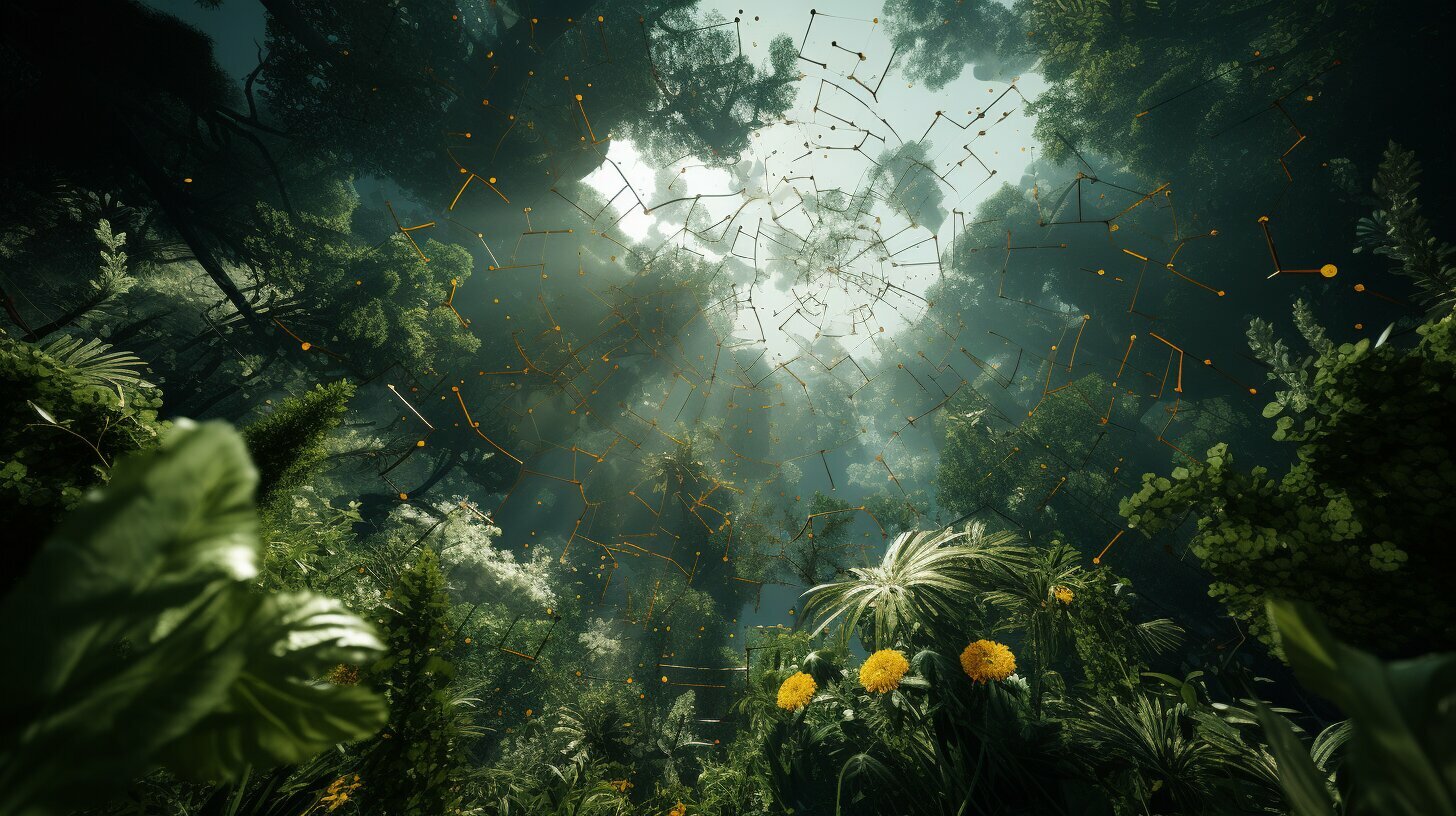As a copywriting journalist, I’m intrigued by the question Can Plants See? Do they have the ability to perceive light in the same way that animals do? Through my research, I’ve discovered that plants have a fascinating sensory world that extends beyond our traditional understanding of visual perception.
Plant vision goes beyond just the ability to see light; it involves a complex interplay of light receptors and chemical signaling that allows plants to perceive their surroundings in a variety of ways. In this article, we’ll delve into the science of plant perception and explore the intricacies of their sensory abilities.
Key Takeaways:
- Plants have a sensory world that extends beyond visual perception.
- Plant perception involves a complex interplay of light receptors and chemical signaling.
- Plant vision is different from animal vision, but it is no less fascinating.
- The study of plant perception is ongoing, and there is still much to learn.
- Plants have a remarkable ability to perceive and respond to their environment.
The Science of Plant Photoreception
When it comes to plant vision, photoreception is the key mechanism that enables plants to perceive light and interpret visual signals. Unlike animals, which have eyes for detecting light, plants have specialized proteins called photoreceptors that enable them to see.
The plant visual system is complex and relies on different types of photoreceptors to detect various wavelengths of light. One of the most well-known examples is the blue light receptor known as cryptochrome, which is involved in regulating the plant’s circadian rhythm.
Other photoreceptors, such as phytochromes, respond to red and far-red light, enabling plants to sense the quality and quantity of light in their environment.
In addition to their role in vision, photoreceptors also play a critical role in regulating various aspects of plant growth and development, such as seed germination and flowering.
The precise mechanisms by which plants perceive light and translate it into growth responses are still being investigated by scientists, but the importance of photoreception in the plant world cannot be overstated.
Understanding Plant Perception
Plants are often perceived as passive organisms, but in reality, they have remarkable sensory abilities that help them gather information about their environment. While visual perception is a significant aspect of plant perception, it is not the only one.
Plants use various mechanisms to perceive their surroundings, including touch, smell, and taste. For instance, plant roots are sensitive to gravity and will grow in the direction of the pull, a phenomenon known as gravitropism. Roots also grow towards sources of nutrients, such as water and minerals, through chemotropism.
Plants can detect changes in temperature and adjust their growth accordingly, a process known as thermotropism. They can also sense vibrations caused by wind or touch, which can influence their growth direction, a phenomenon known as thigmotropism.
Additionally, plants have the ability to detect and respond to different chemicals in their environment, such as those released by predatory insects or neighboring plants. This process is called allelopathy and allows plants to protect themselves from herbivores and compete for resources.
Plants also use photoreception to perceive their environment. They have specialized light-sensitive epidermal cells that can detect changes in light quality, intensity, and direction. This process is vital to their survival as it allows them to adjust their growth and development to optimize their exposure to light.
In conclusion, plant perception involves more than just visual abilities. Plants use various sensory mechanisms to gather information about their environment, allowing them to adjust their growth and development to optimize their survival. Understanding plant perception and sensory abilities is essential in agriculture, ecology, and horticulture.
The Role of Phototropism in Plant Behavior
One of the most fascinating aspects of plant perception is their ability to respond to light stimuli, known as phototropism. Plants can detect the direction and intensity of light and adjust their growth and movement accordingly, allowing them to optimize their energy intake.
Phototropism is not a conscious behavior, but rather a natural response that occurs at the cellular level. Plants contain specialized cells, called photoreceptors, which are sensitive to different wavelengths of light. When a photoreceptor is exposed to light, it triggers a signal that causes the plant to either grow towards or away from the light source.
The most well-known example of phototropism is the way in which a young, growing plant will tilt towards a window to reach the sunlight. This is due to the plant’s perception of the light’s direction and intensity, which influences the growth of the stem and leaves.
| Plant Phototropism Example: |
|---|
Interestingly, plants can also exhibit negative phototropism, where they grow away from a light source. This occurs when the intensity of the light is too strong or when a plant is trying to avoid being shaded by neighboring plants. For example, the roots of plants are known to exhibit negative phototropism, as they grow away from the light and towards nutrients and water in the soil.
The ability of plants to perceive and respond to light is a crucial aspect of their survival. It allows them to optimize their energy intake, avoid shade, and find sources of nutrients and water. Further research into plant phototropism and light perception could have important implications for agriculture and horticulture.
Debunking Plant Eyesight Misconceptions
When it comes to the question of whether plants can see, many misconceptions exist. While plants do possess sensory abilities that allow them to perceive their environment, their visual perception is different from that of animals.
Contrary to popular belief, plants do not have eyes, lenses, or retinas. Rather, they rely on specialized cells called photoreceptors to detect and respond to light. These photoreceptors are sensitive to different wavelengths of light and can help plants determine the direction, intensity, and color of light.
It is important to note that the plant visual system is not the same as animal vision. Plants do not form images or have a conscious experience of their surroundings. Instead, they use light as a source of information to guide their growth, development, and behavior.
While plants may not have eyesight in the traditional sense, they possess a unique and fascinating sensory world that allows them to survive and thrive in their environment. So, next time you see a plant turning towards the sun, remember that it is not “seeing” the sun in the way that we do, but rather responding to light in its own remarkable way.
Conclusion
In conclusion, we have explored the fascinating sensory world of plants, and investigated the question of whether plants can see. While they lack complex eyesight, plants do have sophisticated mechanisms for perceiving light and responding to their environment.
We have learned about the science behind plant photoreception, the role of phototropism in plant behavior, and the different ways in which plants perceive their environment. By debunking common misconceptions about plant eyesight, we have gained a deeper appreciation for the complexity of plant perception.
As science continues to explore the sensory abilities of plants, we can look forward to uncovering more fascinating insights into the world of flora. In the meantime, it is clear that plants are not just passive organisms, but active participants in their environment, responding and adapting to their surroundings in fascinating ways.
FAQ
Q: Can plants see?
A: No, plants do not have eyes or a visual system like humans and animals. However, they have sensory abilities that allow them to perceive light and respond to their environment.
Q: What is plant photoreception?
A: Plant photoreception refers to the ability of plants to detect and respond to light. They have specialized proteins called photoreceptors that enable them to perceive different wavelengths of light and regulate various physiological processes.
Q: How do plants perceive their environment?
A: Plants perceive their environment through various sensory mechanisms. They can detect light, temperature, humidity, gravity, touch, and even chemical signals. These sensory abilities help them adapt and respond to changes in their surroundings.
Q: What is phototropism?
A: Phototropism is the growth or movement of plants in response to light. It allows plants to orient themselves towards a light source to maximize their exposure to sunlight, which is essential for photosynthesis and growth.
Q: Do plants have eyesight like humans?
A: No, plants do not have eyesight like humans. Their sensory perception of light is different from the complex vision system found in animals. Plants use photoreceptors and other mechanisms to detect and respond to light stimuli, but they do not have eyes or visual imagery.





Pingback: Explore Botanic Plant Art - A World of Green & Gorgeous
Pingback: Discovering the World of Botany: How Plants Eat